Israel-Palestinian conflict: Life in the Gaza Strip
Home to 1.9 million people, Gaza is 41km (25 miles) long and 10km wide, an enclave bounded by the Mediterranean Sea, Israel and Egypt.
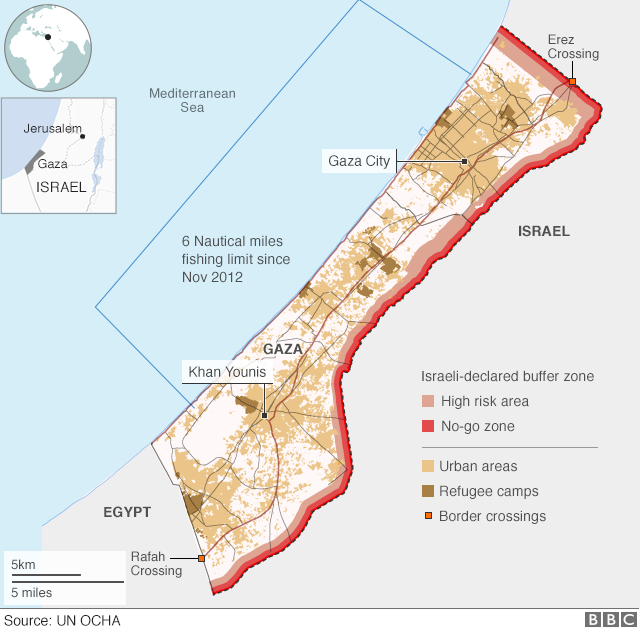
Originally occupied by Egypt, which retains control of Gaza's southern border, the territory was captured by Israel during the 1967 Middle East war. Israel withdrew its troops and around 7,000 settlers in 2005.
It is under the control of the Palestinian Authority, and between 2007 and 2014 was ruled by the militant Islamist group Hamas. They won Palestinian legislative elections in 2006 but then had a violent rift with the rival Fatah faction.
When Hamas took over in Gaza, Israel swiftly imposed a blockade on the territory, restricting the movement of goods and people in and out. Egypt meanwhile blockaded Gaza's southern border.
Hamas and Israel fought a brief conflict in 2014, with the Israelis attempting to end rocket fire from Gaza and the militants fighting to end their isolation.
FREEDOM OF MOVEMENT
Palestinians gather at the Rafah border crossing in southern Gaza, April 2018Image copyrightAFP/GETTY
Image caption
Since Hamas came to power in Gaza in 2007, Egypt
Already limited, freedom of movement and access to Gaza were reduced significantly after mid-2013, when Egypt put new restrictions in place at the Rafah border crossing and launched a crackdown on the network of smuggling tunnels under the Egypt-Gaza border.
Egypt has effectively kept the border closed since October 2014, only opening it in exceptional circumstances. According to a report by the United Nations Office for the Coordination of Humanitarian Affairs (OCHA), the Rafah crossing was partially open for only 17 days up to April 2018, with 23,000 registered and waiting for permission to cross.
In the north, crossings into Israel at Erez have picked up marginally this year compared with 2017, but remain well below pre-blockade levels due to new restrictions.
Fewer than 240 Palestinians left Gaza via Israel in the first half of 2017, compared with a daily average of 26,000 in September 2000.
ECONOMY
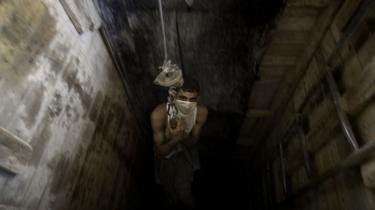
Gaza is significantly poorer than it was in the 1990s. Its economy grew only 0.5% in 2017 according to a World Bank report, with annual income per person falling from $2,659 in 1994 to $1,826 in 2018.
In 2017 the Gaza Strip had the highest unemployment rate in the World Bank's development database.
At 44% it was more than double the rate in the West Bank.
And of particular concern was the high youth unemployment rate, which stood at more than 60% in Gaza.
The latest data shows Gaza's poverty rate stands at 39%, more than twice the rate in the West Bank. The World Bank believes this would rise even higher were it not for social aid payments, mostly through the United Nations Relief and Works Agency (UNRWA).
The agency says 80% of the population are on some form of social assistance.
EDUCATIO
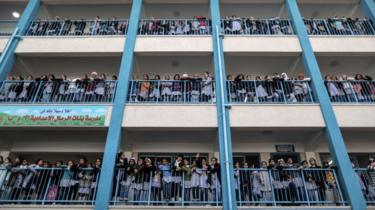
Gaza's school system is under pressure. According to UNRWA, 94% of schools run a "double shift" system, with one school of students in the morning and another in the afternoon.
While UNRWA runs around 250 schools in the territory, which has pushed the literacy rate up to 97%, non-UN schools have suffered. The 2014 conflict damaged 547 schools, kindergartens and colleges, many of which have yet to be repaired.
This means there are larger and larger class sizes, with the UN reporting an average classroom of around 40 pupils in 2017.
A report by the UN Fund for Population Activities (UNFPA) predicts the number of students in Gaza will grow from 630,000 in 2015 to 1.2 million by 2030, which means the Strip will need 900 more schools and 23,000 more teachers.
POPULATION
Gaza has one of the highest population densities in the world. On average, some 5,479 people live on every square kilometre in Gaza. That's expected to rise to 6,197 people per square kilometre by 2020.
The number of people living there is expected to hit 2.2 million by the end of the decade, and 3.1 million by 2030.
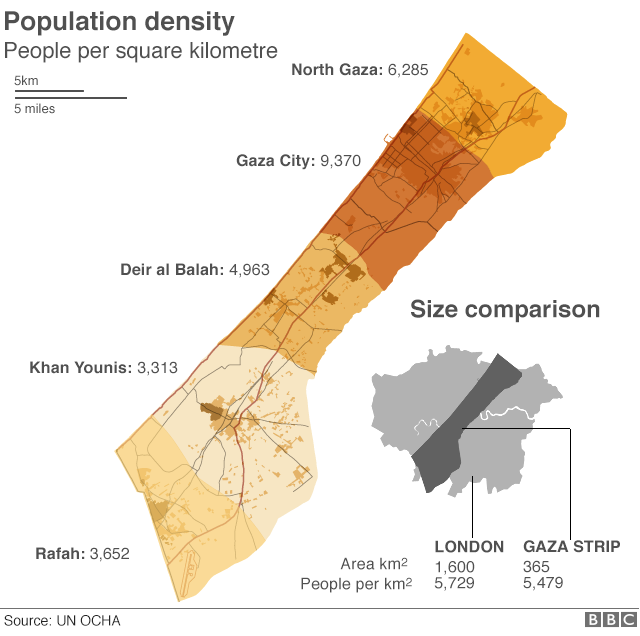
srael declared a buffer zone along the border in 2014 to protect itself from rocket attacks and tunnels. The zone reduces the amount of land available for people to live or farm on.
The UN says there is a shortage of 120,000 housing units due to natural population growth, as well as damage caused by the 2014 conflict. They believe around 29,000 people remain displaced more than three years after the end of the conflict.
Gaza also has one of the world's youngest populations, with more than 40% younger than 15 years old.
graph of Gaza population age, showing highest numbers of children and teenagers
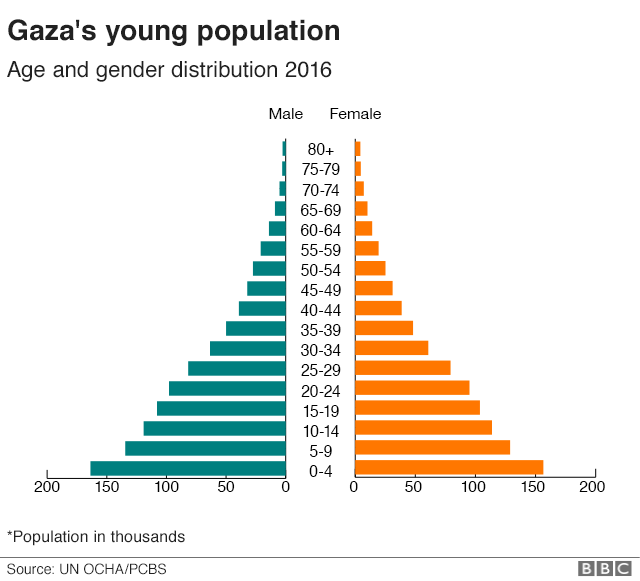
HEALTH
Palestinian women undergo kidney dialysis at the Al-Shifa hospital in Gaza, April 2017Image copyrightAFP/GETTY
Image caption
Electricity and fuel shortages have disrupted the functioning of medical facilities
Access to public health services has worsened due to border restrictions.
The closure of the Rafah crossing reduced the number of patients travelling to Egypt for treatment. Before 2014, the World Health Organisation (WHO) said a monthly average of 4,000 people crossed into Egypt for health reasons alone.
Exit passes through Israel have also dropped in recent years, with approvals for medical reasons dropping from 93% in 2012 to 54% in 2017.
Moreover, drugs, supplies and equipment are all restricted because of the blockade - including dialysis machines and heart monitors.
Just as in education, the UN helps out by running 22 healthcare facilities. But a number of hospitals and clinics were damaged or destroyed in previous conflicts with Israel, with the total number of primary health care clinics falling from 56 to 49 since 2000 - in the same time as the population doubled.
A recent fuel shortage for generators has also affected medical services. The Palestinian Ministry of Health says three hospitals and ten medical centres have suspended services due to a lack of power.
FOOD
Palestinian boat by Gaza City February 2018Image copyrightAFP/GETTY
Image caption
Not so long ago, Gaza had a thriving fishing industry
More than a million people in Gaza are classed as "moderately-to-severely food insecure", according to the UN, despite many receiving some form of food aid.
Israeli restrictions on access to agricultural land and fishing add to the challenges.
Gazans are not allowed to farm in the Israeli-declared buffer zone - 1.5km (0.9 miles) wide on the Gaza side of the border - and this has led to a loss in production of an estimated 75,000 tonnes of produce a year.
The restricted area coincides with what is considered Gaza's best arable land, and the Strip's agriculture sector has dropped from 11% of GDP in 1994 to less than 5% in 2018.
Israel imposes a fishing limit meaning Gazans can only fish within a certain distance of the shore. The UN says if the limit were lifted, fishing could provide employment and a cheap source of protein for the people of Gaza.
Following the November 2012 ceasefire agreement between Israel and Hamas, the fishing limit was extended from three nautical miles to six. However, it has been periodically reduced to three nautical miles in response to rocket fire from Gaza. Israeli naval forces frequently open fire towards Palestinian fishing boats approaching or exceeding the limit.
POWER
Palestinian children do homeowrk by candlelight September 2017Image copyrightAFP/GETTY
Image caption
Power cuts in Gaza disrupt almost all aspects of daily life
Power cuts are an everyday occurrence in Gaza. On average, Gazans get only three-six hours of electricity a day.
The Strip gets most of its power from Israel together with further contributions from Gaza's only power plant and a small amount from Egypt. However, this all amounts to less than a third of the power it needs, according to the World Bank.
PA 'stops paying for Gaza electricity'
Both the Gaza Power Plant (GPP) and many people's individual generators depend on diesel fuel, which is very expensive and in short supply.
Offshore there is a gas field which the UN says could provide all the territory's power needs if it were developed. Any surplus could be ploughed into development.
The GPP was originally designed to run on natural gas, and the World Bank estimates reconverting the plant to run on gas would save millions of dollars and increase output fivefold.
WATER AND SANITATION
A man walks in a flooded area in northern Gaza, February 2017Image copyrightAFP/GETTY
Image caption
Heavy rainfall has overwhelmed Gaza's storm water and sewage systems in the past
Gaza has little rain and no major fresh water source to replenish its underground water supplies, which are not large enough to keep up with demand.
While most Gaza households are on a piped water network, the World Bank says supply is inconsistent and often poor quality. 97% of Gaza households depend on water delivered by tanker trucks.
Sewage is another problem. Although 78% of households are connected to public sewage networks, treatment plants are overloaded. Around 90 million litres of partially treated and raw sewage is pumped in to the Mediterranean and open ponds daily - meaning 95% of groundwater in the Strip is polluted.
There is also the risk that this sewage can flow into the streets, which could cause further health problems in the territory.